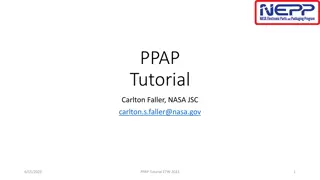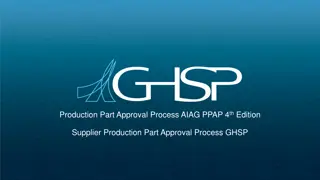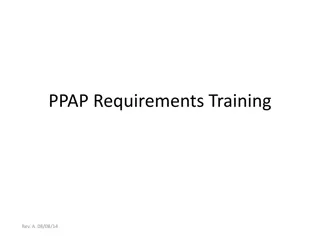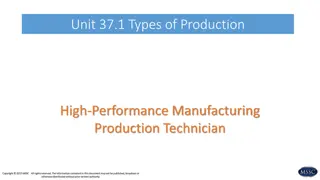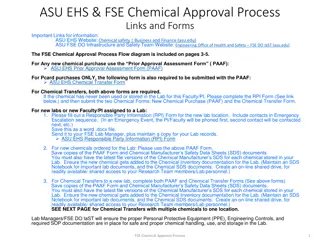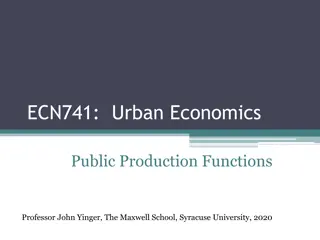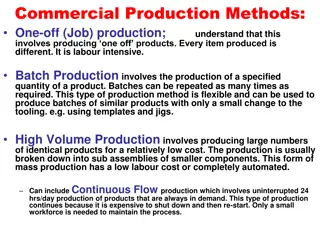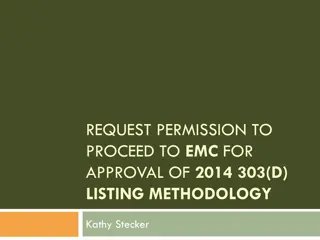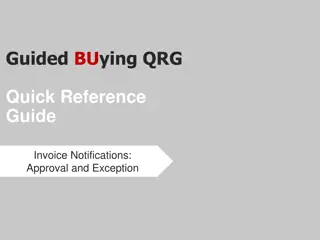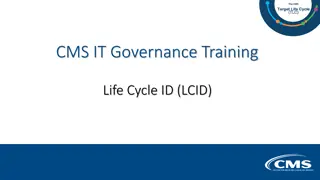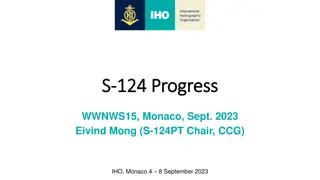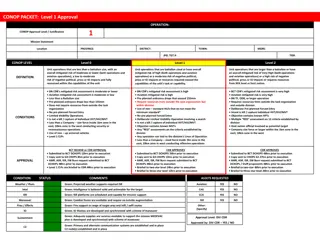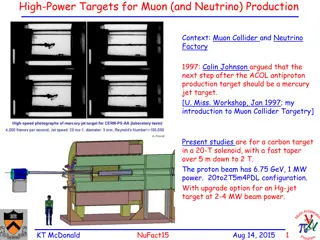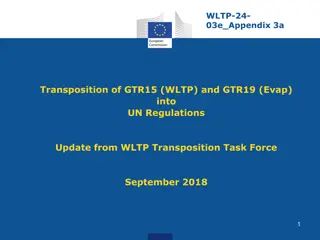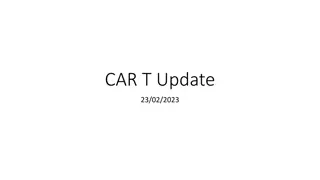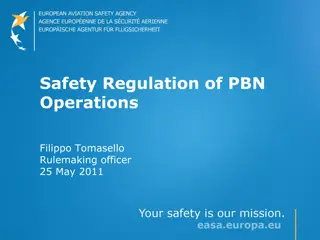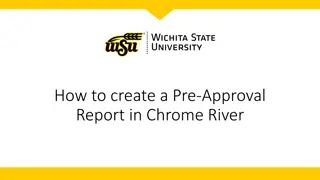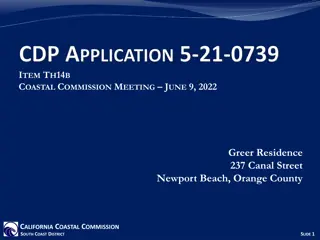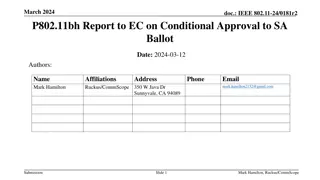Understanding the Jabil Production Parts Approval Process (PPAP)
The Jabil Production Parts Approval Process (PPAP) is a standardized approach used to mitigate risks before the release of a product or service. Initially developed by AIAG in 1993, PPAP has evolved beyond the automotive industry to various sectors. This systematic process ensures that customer engineering design requirements are met, manufacturing processes are capable, and product quality is maintained. By requiring a significant production run and submission of necessary documentation, PPAP helps organizations maintain design integrity, identify and resolve issues early, reduce warranty charges, and enhance overall product quality.
- Jabil PPAP
- Production Parts Approval Process
- Risk Management
- Quality Assurance
- Manufacturing Standards
Download Presentation

Please find below an Image/Link to download the presentation.
The content on the website is provided AS IS for your information and personal use only. It may not be sold, licensed, or shared on other websites without obtaining consent from the author. Download presentation by click this link. If you encounter any issues during the download, it is possible that the publisher has removed the file from their server.
E N D
Presentation Transcript
Jabil Production Parts Approval Process Introduction Risk Office | Regulatory Compliance Team George Zhou
Contents 1. General Introduction of PPAP 2. General Jabil PPAP Requirements 3. Jabil PPAP Templates 4. Reference Documents
General Introduction of PPAP What is PPAP? PPAP: Production Part Approval Process Standard used to reduce risks prior to product or service release, in a team-oriented manner using well established tools and techniques. Initially developed by AIAG (Auto Industry Action Group) in 1993 with input from the Big 3 - Ford, Chrysler, and GM . AIAG s 4thedition effective June 1, 2006 is the most recent version. PPAP has now spread to many different industries beyond automotive. JPPAP: Jabil Production Part Approval Process. It s a process that Jabil uses to qualify the purchasing parts / components from supplier.
General Introduction of PPAP Purpose of PPAP Provide evidence that all customer engineering design record and specification requirements are properly understood by the organization. To demonstrate that the manufacturing process has the potential to produce product that consistently meets all requirements during an actual production run at the quoted production rate. PPAP manages change and ensures product conformance!
General Introduction of PPAP Benefits of PPAP Submissions Helps to maintain design integrity. Identifies issues early for resolution. Reduces warranty charges and prevents cost of poor quality. Assists with managing supplier changes. Prevents use of unapproved and nonconforming parts. Identifies suppliers that need more development. Improves the overall quality of the product & customer satisfaction.
General Introduction of PPAP Significant Production Run The production parts for PPAP shall be taken from a significant production run that: From 1 hour to 8 hours of production and minimum 300 consecutive parts. Conducted at the production site. Conducted at the production rate. Using the production tooling, gaging and process. Using the production materials. Using the production operators.
General Jabil PPAP Requirements When PPAP is required Suppliers may be requested to provide a PPAP submission based on the following, but not limited to: Jabil Customer Requirements. Jabil Site / Business needs. Jabil Design needs. Jabil New Product Introduction needs. Change in material or sub-supplier. Production following a location change of manufacturing Refer to next page for the situations that may trigger a PPAP submission.
General Jabil PPAP Requirements When PPAP is required Initial Submission Engineering Changes to design records Tooling Transfer, Replacement, Refurbishment Correction of Discrepancy Change to Optional Construction or Material Sub-supplier or Material Source Change Change in Part Processing Tooling Inactive > than 1 year Parts Produced at Additional Location Other situations required by Jabil Representative PPAP is required with any significant change to product or process!
General Jabil PPAP Requirements PPAP submission levels Supplier shall submit the PPAP items specified in below table per the PPAP submission level. Default submission level is level 3. However, Jabil presentative may change to other submission level base on the part and the manufacturing process s complexity. Production Warrant and Appearance Approval Report (if applicable) submitted to Jabil Production Warrant, product samples, and limited supporting data submitted to Jabil Production Warrant, product samples, and complete supporting data submitted to Jabil Level 1 Level 2 Level 3 Production Warrant and other requirements as defined by Jabil Production Warrant, product samples and complete supporting data for review at the supplier's manufacturing location Level 4 Level 5
General Jabil PPAP Requirements The detailed submission items follow below table. SUBMISSION LEVEL SUBMISSION LEVEL Level 1 Level 1 Requirement Requirement Level 2 Level 2 S S R R R R R R S S R S Level 3 Level 3 S S S S S S S S S S S S Level 4 Level 4 * * * * * * * * * * * * Level 5 Level 5 R R R R R R R R R R R R 1. 2. 3. 4. 5. 6. 7. 8. 9. 10. 11. 12. Design Record Engineering Change Documents, if any Customer Engineering Approval, if required Design FMEA Process Flow Diagrams Process FMEA Control Plan Gage Repeatability and Reproducibility Report Dimension Results-FAIR Material, Performance Test Results Initial Process Studies-Cpk Qualified Laboratory Documentation Appearance Approval Report (AAR), if applicable Sample Product Master Sample Checking Aids-Gauge List Record of Compliance With Customer-Specific Requirements, if applicable Part Submission Warrant (PSW) R R R R R R R R R R R R 13. S S S * R 14. 15. 16. R R R S R R S R R * * * R R R 17. R R S * R 18. S S S S R S = The supplier shall submit designated product approval activity and retain a copy of records or documentation items at appropriate locations including manufacturing. R = Supplier shall retain at appropriate locations, including manufacturing, and make readily available to Jabil representative upon request. * = If applicable or required.
General Jabil PPAP Requirements PPAP submission method Supplier should submit PPAP to Jabil through Jabil s E-JPPAP system, unless customer requires to use other methods. Jabil users need to apply the access to E-JPPAP system. Then Jabil users can create PPAP request and review the PPAP submit by supplier in this system. Suppliers don t need account and password to the E-JPPAP system. They will receive the E-JPPAP system notification e-mail when a PPAP case is assigned to them. Supplier will access the PPAP case via the case s link in the notification e-mail to submit the PPAP. Each single PPAP case has a unique case link.
General Jabil PPAP Requirements PPAP Review After supplier submit the PPAP to Jabil, Jabil representatives will review the PPAP. There will be 2 kinds of review result: Approved: The PPAP documents and samples meet Jabil requirements. Rejected: The PPAP documents and samples don t meet Jabil requirements. The PPAP will be returned to supplier. Supplier must take actions for the discrepancies and re-submit the PPAP to Jabil. These steps may be iterated until the PPAP be approved by Jabil.
JPPAP Templates Overview Jabil PPAP templates should be used when supplier submit PPAP to Jabil. Unless: Jabil s customer requests to use their template. In this case, customer requirements will take precedence. Jabil did not create the template for the elements. Supplier should use their own format and insert the file to Jabil template. Include: Design Record, Authorized Engineering Change Documents Customer Engineering Approval Process Flow Diagram(s) Material, Performance Test Results Qualified Laboratory Documentation and some Jabil-Specific Requirements. Jabil allow supplier to use equivalent format per Jabil PPAP procedure. Supplier shall get the acceptance from Jabil representative to use the equivalent format before submit it to Jabil. Include: Design FMEA Process FMEA Control Plan Gage Repeatability and Reproducibility Report Dimensional Results - FAIR Initial Process Studies Cpk.
JPPAP Templates Overview Supplier can download the Jabil templates by the links in the notification e-mail when PPAP case be assigned to supplier. Supplier only input in the blank fields in Jabil PPAP templates, do not edit the blue color cells.
JPPAP Templates Part Submission Warrant It requires to use Jabil template unless customer has special requirements. Supplier input the basic project data and part data in below fields. Supplier input the supplier & facility data and acknowledge the declaration in below fields.
JPPAP Templates Part Submission Warrant Supplier tick to select the submission reason, submission documents, claim does parts meet all drawing specifications and cosmetic acceptable or not.
JPPAP Templates Part Submission Warrant Supplier claims the customer tool identification status, input the comments and supplier representative sign the PPAP. Below fields will be filled by Jabil after review the PPAP. Not by supplier.
JPPAP Templates Design Record It only applies to supplier who has design responsibility / authority. It includes drawing, specification, etc. It uses supplier s format. Supplier should insert it to Jabil s Design Record template.
JPPAP Templates Authorized Engineering Change Documents supplier shall provide authorized change documents for those changes not yet recorded in the design record, but incorporated in the product, part or tooling, such as: ECNs, Specifications, Supplier change requests, etc. It uses supplier s format. Supplier should insert it to Jabil s Authorized Engineering Change template.
JPPAP Templates Customer Engineering Approval Where specified by Customer/Jabil, the supplier shall have evidence of Customer/Jabil engineering Approval, e.g., customer approval for design record or ECN. It uses supplier s format. Supplier should insert it to Jabil s Customer Engineering Approval template.
JPPAP Templates FMEA FMEA is a common approach to address: Potential product or process failure to meet expectations Potential consequences Potential causes of the failure mode Application of current controls Level of risk / prioritization Risk reduction
JPPAP Templates Design FMEA It only applies to supplier who has design responsibility / authority. The product design-responsible supplier shall develop a Design FMEA in accordance with, and compliant to, customer requirements. It must be developed and maintained by a cross-function team. It uses Jabil s format, or equivalent format if accepted by Jabil.
JPPAP Templates Process FMEA It applies to all suppliers who have manufacturing process. The process steps in PFMEA must align to the process flow diagram and the process control plan. It must be developed and maintained by a cross-function team. It uses Jabil s format, or equivalent format if accepted by Jabil.
FMEA - Step 1 General steps to develop FMEA. Take PFMEA as an example. Potential Cause(s)/ Mechanism(s) of Failure Potential Effect(s) of Failure For each Process Input, determine the ways in which the input can go wrong. Failure Modes R.P.N. Occur Detec Class Potential Failure Mode Current Process Controls Sev Process Step Op 70: Manual application of wax inside door panel Insufficient wax coverage over specified surface Allows integrity breach of inner door panel 7 Manually inserted spray head not inserter far enough 8 Variables check for film thickness; Visual check for coverage 5 280 Corroded interior lower door panels Spray head clogged: - Viscosity too high - Temp too low - Pressure too low 5 Variables check for film thickness; Visual check for coverage; Test spray at start-up and after idle periods and preventative maintenance program to clean heads 5 175 Deteriorated life of door leading to: - Unsatisfactory appearance due to rust through paint over time - Impaired function of interior door hardware Using the completed Process Flow Diagram, enter the process step. TIPS There should be at least one failure mode for each input.
FMEA - Step 2 Potential Cause(s)/ Mechanism(s) of Failure Potential Effect(s) of Failure R.P.N. Occur Detec Class Potential Failure Mode Current Process Controls Sev Process Step Op 70: Manual application of wax inside door panel Insufficient wax coverage over specified surface Allows integrity breach of inner door panel 7 Manually inserted spray head not inserter far enough For each Failure Mode, determine what effect the specific failure could have on the process output. 8 Variables check for film thickness; Visual check for coverage 5 280 Potential Failure Effects Corroded interior lower door panels Spray head clogged: - Viscosity too high - Temp too low - Pressure too low 5 Variables check for film thickness; Visual check for coverage; Test spray at start-up and after idle periods and preventative maintenance program to clean heads 5 175 Deteriorated life of door leading to: - Unsatisfactory appearance due to rust through paint over time - Impaired function of interior door hardware TIPS There should be at least one failure effect for each failure mode. Effects should be specific, clear, and leave no doubt to the uninformed reviewer.
FMEA - Step 3 Potential Cause(s)/ Mechanism(s) of Failure Potential Effect(s) of Failure R.P.N. Occur Detec Class Potential Failure Mode Current Process Controls Sev Process Step Op 70: Manual application of wax inside door panel Potential Causes For each Failure Mode, determine the possible cause of the failure. Insufficient wax coverage over specified surface Allows integrity breach of inner door panel 7 Manually inserted spray head not inserted far enough 8 Variables check for film thickness; Visual check for coverage 5 280 Corroded interior lower door panels Spray head clogged: - Viscosity too high - Temp too low - Pressure too low 5 Variables check for film thickness; Visual check for coverage; Test spray at start-up and after idle periods and preventative maintenance program to clean heads 5 175 Deteriorated life of door leading to: - Unsatisfactory appearance due to rust through paint over time - Impaired function of interior door hardware TIPS There should be at least one potential cause for each failure mode.
FMEA - Step 4 Potential Cause(s)/ Mechanism(s) of Failure Potential Effect(s) of Failure R.P.N. Occur Detec Class Potential Failure Mode Current Process Controls Sev Process Step Op 70: Manual application of wax inside door panel Insufficient wax coverage over specified surface Allows integrity breach of inner door panel Current Controls For each potential cause, list the current method used for preventing or detecting failure. 7 Manually inserted spray head not inserter far enough 8 Variables check for film thickness; Visual check for coverage 5 280 Corroded interior lower door panels Spray head clogged: - Viscosity too high - Temp too low - Pressure too low 5 Variables check for film thickness; Visual check for coverage; Test spray at start-up and after idle periods and preventative maintenance program to clean heads 5 175 Deteriorated life of door leading to: - Unsatisfactory appearance due to rust through paint over time - Impaired function of interior door hardware TIPS This step in the FMEA begins to identify initial shortcomings or gaps in the current control plan. If a procedure exists, enter the document number. If no current control exists, list as none.
FMEA - Step 5 Assign Severity, Occurrence, and Detection ratings Potential Cause(s)/ Mechanism(s) of Failure Potential Effect(s) of Failure R.P.N. Occur Detec Class Potential Failure Mode Current Process Controls Sev Process Step Assign Severity (How serious is the effect if it fails?) Op 70: Manual application of wax inside door panel Insufficient wax coverage over specified surface Allows integrity breach of inner door panel 7 Manually inserted spray head not inserter far enough cause or failure mode be detected?) 8 Variables check for film thickness; Visual check for coverage 5 280 Assign Detection (How easily can the Corroded interior lower door panels Spray head clogged: - Viscosity too high - Temp too low - Pressure too low 5 Variables check for film thickness; Visual check for coverage; Test spray at start-up and after idle periods and preventative maintenance program to clean heads 5 175 Deteriorated life of door leading to: - Unsatisfactory appearance due to rust through paint over time - Impaired function of interior door hardware Assign Occurrence (How likely is the cause to occur?) Severity, Occurrence and Detection rating details on next slide
PFMEA - Definition of Terms Severity (of Effect) - severity of the effect on the Customer and other stakeholders (Higher Value = Higher Severity) Occurrence (of Cause) - frequency with which a given Cause occurs and creates Failure Mode. (Higher Value = Higher Probability of Occurrence) Detection (Capability of Current Controls) - ability of current control scheme to detect the cause before creating the failure mode and/or the failure mode before suffering the effect (Higher Value = Lower Ability to Detect) Caution: Notice the scale difference for Detection!
Example of Rating Definitions Rating High Severity Hazardous without warning Occurrence Very high and almost inevitable Detection* Cannot detect or detection with very low probability Remote or low chance of detection Low detection probability 10 Loss of primary function High repeated failures Loss of secondary function Minor defect Moderate failures Occasional failures Moderate detection probability Almost certain detection No effect Failure unlikely Low 1 *If No Controls Exist, Detection = 10 Create a rating system that makes sense for the defects you are trying to prevent.
PFMEA - Step 6 Potential Cause(s)/ Mechanism(s) of Failure Potential Effect(s) of Failure R.P.N. Occur Detec Class Potential Failure Mode Current Process Controls Sev Process Step Op 70: Manual application of wax inside door panel Insufficient wax coverage over specified surface Allows integrity breach of inner door panel 7 Manually inserted spray head not inserter far enough 8 Variables check for film thickness; Visual check for coverage 5 280 Calculate the Risk Priority Number RPN = Severity x Occurrence x Detection Corroded interior lower door panels Spray head clogged: - Viscosity too high - Temp too low - Pressure too low 5 Variables check for film thickness; Visual check for coverage; Test spray at start-up and after idle periods and preventative maintenance program to clean heads 5 175 Deteriorated life of door leading to: - Unsatisfactory appearance due to rust through paint over time - Impaired function of interior door hardware TIPS The RPN is used to prioritize the most critical risks identified in the first half of the FMEA. High RPNs are flags to take effort to reduce the calculated risk. Regardless of RPN, high Severity scores (9 or 10) should be given special attention.
PFMEA Remediation Guidelines Severity can only be improved by a design change to the product Occurrence can only be reduced by a change which removes or controls a cause. Examples are redundancy, substituting a more reliable component or function or mistake-proofing. Detection can be reduced by improving detection. Examples are mistake-proofing, simplification and statistically sound monitoring. In general, reducing the Occurrence is preferable to improving the Detection
FMEA Step 7 Determine Actions Recommended to reduce High RPNs Action Results Potential Effect(s) of Failure R.P.N. Potential Failure Mode Recommended Actions Responsibility & Target Date R.P.N. Process Step Occ Sev Det Actions Taken Op 70: Manual application of wax inside door panel Insufficient wax coverage over specified surface Allows integrity breach of inner door panel 280 Add positive depth stop to sprayer Automate spraying Mfg. Eng. By 5/10/10 Stop added, sprayer checked on-line Rejected due to complexity of different doors on the same line Temp and press limits were determined and limit controls have been installed - Control charts show process is in control Cpk = 1.85 7 2 5 70 Mfg. Eng. By 5/25/10 Corroded interior lower door panels For the high RPN numbers, determine the recommended actions. 175 Use DOE on viscosity vs. temp vs. pressure Mfg. Eng. By 5/31/10 7 1 5 35 Deteriorated life of door leading to: - Unsatisfactory appearance due to rust through paint over time - Impaired function of interior door hardware
FMEA Steps 8 and 9 Action Results Potential Effect(s) of Failure R.P.N. Potential Failure Mode Resp (responsibility) Assign a specific person who will be responsible for recommended actions. Recommended Actions Responsibility & Target Date R.P.N. Process Step Occ Sev Det Actions Taken Op 70: Manual application of wax inside door panel Insufficient wax coverage over specified surface Allows integrity breach of inner door panel 280 Add positive depth stop to sprayer Automate spraying Mfg. Eng. By 5/10/10 Stop added, sprayer checked on-line Rejected due to complexity of different doors on the same line Temp and press limits were determined and limit controls have been installed - Control charts show process is in control Cpk = 1.85 7 2 5 70 Mfg. Eng. By 5/25/10 Corroded interior lower door panels As actions are identified and completed, document in the Actions Taken column. Actions Taken 175 Use DOE on viscosity vs. temp vs. pressure Mfg. Eng. By 5/31/10 7 1 5 35 Deteriorated life of door leading to: - Unsatisfactory appearance due to rust through paint over time - Impaired function of interior door hardware SEV, OCC, DET, RPN As actions are complete reassess Severity, Occurrence, and Detection and recalculate RPN. Now recalculate your RPNs based on mitigation plans. TIPS: Continue updating the actions taken and resulting RPNs until all risks are at an acceptable level.
Summary Steps To Complete a FMEA 1. For each Process Input, determine the ways in which the Process Step can go wrong (these are Failure Modes). 2. For each Failure Mode associated with the inputs, determine Effects on the outputs. 3. Identify potential Causes of each Failure Mode. 4. List the Current Controls for each Cause. 5. Assign Severity, Occurrence and Detection ratings after creating a ratings key appropriate for your project. 6. Calculate RPN. 7. Determine Recommended Actions to reduce High RPNs. 8. Take appropriate Actions and Document. 9. Recalculate RPNs. 10. Revisit steps 7 and 8 until all the significant RPNs have been addressed.
JPPAP Templates Process Flow Diagram Supplier shall have a process flow diagram that clearly describe the production process steps and sequence. The process flow once submitted and accepted cannot be altered without Jabil approval and resubmission of JPPAP. It uses supplier s format. Supplier should insert it to Jabil s Process Flow Diagram template.
JPPAP Templates Process Flow Diagram _ example
JPPAP Templates Process Control Plan Supplier shall have a Control Plan that defines all methods used for process control and complies with customer-specified requirements. The process flow in control plan must align to the process flow diagram and the process FMEA. It uses Jabil s format, or equivalent format if accepted by Jabil.
JPPAP Templates Tool Interaction Key S E V O C C D E T R P N E O C S E V O C C D E T R P N Potential Failure Mode Potential Failure Effects Actions Recommended Department/Group Project High Level Process Map Project Idea 6 Sigma Project High Level Process Map Process Step Process Input Potential Causes Current Controls Resp. Actions Taken Fill Out Master Form with Initial Information Process Steps Receive Payment Checks Delay internal mail AR balance does not go down Inadequate staffing in mail room None Investigate mail room staffing and associated processes G. Lee Added another mail clerk. Adjusted dock schedule. Other Required Signatures: Segment CEO Champion Process Owner BB or GB Other Required Signatures: Champion: Process Owner Project Owner Dept GB/BB/MBB 7 7 10 490 7 1 10 70 6 Sigma Assigns Project Number Group Assigns Project Number Get DLN Assigned Get WO Assigned Prefer to work this project within your area? No Monitor Progress through Power Steering and Monthly Financial Reviews Begin/Work Project Monitor Progress through Bi- Weekly Updates and Monthly Reviews Begin/Work Project Identify Customer Wire Transfer reference line Information not supplied AR balance is past due Customer or bank did not include name and/or account info on wire transfer Acct identifies problem when trying to apply payment Poka-Yoke wire transer process N. Peart Contacted banks and established wire transfer procedure (DI 2112) Yes Finance Approval and Signature Finance Approval and Signature Follow DMAIC or DFSS process Follow DMAIC or DFSS process Do you No have BB/GB to Assist/Work the project? 10 5 5 250 10 1 3 30 Master Form Will Generate Contract Complete Project (Has to be fully Documented Complete Project (Has to be fully Documented) Yes Master Form Will Generate Contract Yes Is Hard Savings > $??? Identify Invoice Checks Incorrect invoice supplied Invoice shows outstanding (AR balance does go down) Customer error Customer might catch it when reviewing the next statement Provide payment stub with statement for each invoice A. Lifeson Revised statement to include payment stub with each invoice. Enter Remaining Information on Master Form 6 Sigma Project Final Project Review Final Project Review No 5 5 10 250 5 1 5 25 Does the Project Involve Only Your Group? Department or Group Project Enter Remaining Information on Master Form Yes Finance Approval and Signature Finance Approval and Signature New/Revised Process Steps No Identify Invoice Checks Invoice number not supplied Invoice shows outstanding (AR balance does go down) Customer error Acct identifies problem when trying to apply payment Provide payment stub with statement for each invoice S. Hagar Revised statement to include payment stub with each invoice. Does the Project Involve >2 Groups in Eng? Other Required Signatures: Champion: Dir T&E Process Owner Project Owner Dept BB or MBB Other Required Signatures: Champion: Dir T&E Process Owner Project Owner Dept BB or MBB No 5 10 5 250 5 1 5 25 Yes Complete all Documentation including a (1) Page Close- out Sheet Complete all Documentation including a (1) Page Close- out Sheet Does the Project Involve >3 Depts. outside Eng? Close Project Close Project Yes No Process FMEA Process Flowchart Control Plan
JPPAP Templates Gauge R&R To be executed on all critical process control features (to control identified product critical characteristics) identified on engineering documentation, including continued use of data for process characterization. It uses Jabil s format, or equivalent format if accepted by Jabil.
JPPAP Templates Gauge R&R Gage R&R is the combined estimate of measurement system Repeatability and Reproducibility. Typically, a 3-person study is performed Each person randomly measures 10 marked parts per trial Each person can perform up to 3 trials There are 3 key indicators EV or Equipment Variation AV or Appraiser Variation Overall % GRR Number of Distinct Categories (NDC)
JPPAP Templates Step 1 Step 2 Step 4 Step 3 Step 6 Step 7 Step 8 Step 9 Step 10 Step 5 1. Select 10 items that represent the full range of long-term process variation. 2. Identify the appraisers. 3. If appropriate, calibrate the gage or verify that the last calibration date is valid. 4. Open the Gage R&R worksheet in the JPPAP template to record data. 5. Ask each appraiser to assess each part 3 times (trials first in order, second in reverse order, third random). 6. Input data into the Gage R&R worksheet. 7. Enter the number of operators, trials, samples and specification limits 8. Analyze data in the Gage R&R worksheet. 9. Assess MSA trust level. 10. Take actions for improvement if necessary.
JPPAP Templates Gauge R&R
JPPAP Templates Gauge R&R
JPPAP Templates GR&R instruction and result analysis.
JPPAP Templates Dimensional Results FAIR It proves that dimensional verifications have been completed and results indicate compliance with specified requirements. Supplier shall submit a minimum of three (3) samples of each part or assembly, from each tool and/or cavity. Samples shall be taken from normal settings or parameters established by the supplier to be used during normal production and shall be produced by means following the referenced production Process Flow Diagram. If the values identified in this report do not meet the requirements as defined on the piece part print, Supplier must notify Jabil via the Parts Submission Warrant block titled: Submission Results. If the parts fail to meet any JPPAP requirements, supplier must address with cause and corrective action for discrepancies via Deviation-Action Template. It uses Jabil s format, or equivalent format if accepted by Jabil.
JPPAP Templates Dimensional Results FAIR
JPPAP Templates Material, Performance Test Results Supplier shall have records of material and/or performance test results for tests specified on the design record or Control Plan It uses supplier s format. Supplier should insert it to Jabil s Matl & Perf Test Result template.
Material / Performance Test Results Material Test Results The supplier shall perform tests for all parts and product materials when chemical, physical, or metallurgical requirements are specified by the design record or Control Plan For products with Jabil-developed material specifications and/or an Jabil- approved supplier list, the supplier shall procure materials and/or services from suppliers on that list Performance Test Results The supplier shall perform tests for all parts or product materials when performance or functional requirements are specified by the design record or Control Plan
JPPAP Templates Initial Process Studies-Cpk The purpose of the initial process study is to determine if the production process is likely to consistently produce products that meet customer s requirements. The initial process studies should cover all special characteristics designated by customer or Jabil. Supplier shall complete measurement system analysis before the initial process study. The study should be done on a minimum 30 random pieces that taken from a minimum population of 300 pieces produced in significant production run. If the sample quantity is not enough before PPAP submission, Jabil may require initial process study in mass production. Minimum acceptable Cpk value is 1.67, unless a specific Cpk value is defined by customer or Jabil site/division. It uses Jabil s format, or equivalent format if accepted by Jabil.


